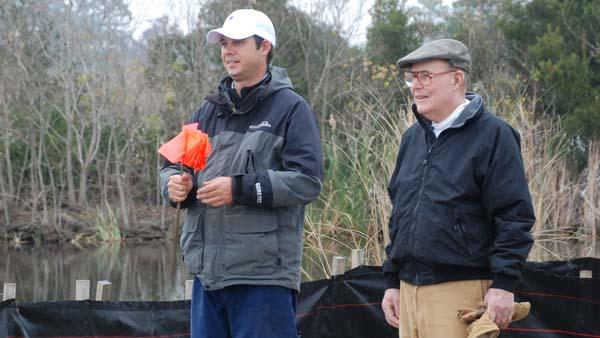 It's not often that a golf course superintendent is paid to lie down on the job. Members at The Ford Plantation have grown accustomed to superintendent Nelson Caron doing just that since he started working at the course in Richmond Hill, Georgia.
It's not often that a golf course superintendent is paid to lie down on the job. Members at The Ford Plantation have grown accustomed to superintendent Nelson Caron doing just that since he started working at the course in Richmond Hill, Georgia.The son of a research scientist who has won worldwide acclaim for research in such areas as Parkinson's disease, Caron attacks turfgrass management from a science-based approach.
"One day I was walking playing golf, and I noticed a body, lying prone on the green. Concerned, I hurried to the green to see what was the matter, only to find Nelson staring into a microscope at the turfgrass," wrote Dr. Bill Thompson, green committee chairman at The Ford Plantation, in his letter nominating Caron for the 2014 TurfNet Superintendent of the Year. "This was my first introduction to our new GCS, and as a physician I knew things were about to change at Ford."
For his many accomplishments at The Ford Plantation, Caron has been named one of 10 finalists for the TurfNet Superintendent of the Year Award, presented by Syngenta.
Caron, 38, maintains a collection of various types of field microscopes that he uses to scout for early signs of disease as well as quality of cut and plant density.

"You can really monitor secondary growth, which turns into primary growth," Caron said. "Then you can make adjustments to your cultural practices. It concerns people. They don't generally see people lying down on the job.
"We have to see if the bedknife is dragging and if the leaf is crisply cut. You can't really see that with the naked eye. Some say they can, but when you're mowing as low as we are, you have to take it to the next level."
Caron elevated the standards at Ford Plantation during a recent $7.5 million of the 30-year-old Pete Dye design. In fact, Dye, who vouched for Caron when Ford Plantation members were searching for a new superintendent seven years ago, came back to the Georgia coast to work on the redesign.
Even though Dye was the architect of record, make no mistake - Caron was in charge of the project from beginning to end.
"To get to rebuild a Pete Dye golf course with Pete Dye, who actually helped me get this job, and manage Pete Dye as the project manager, it actually did turn my hair gray," Caron said.
"There was not one part of this 140 acres that was not completely blown up and rebuilt."
Much of the impetus for the renovation project was to improve drainage and playability, because so much of the property is at sea level, or lower. And that can be a source for many challenges at a property in such close proximity to water. The project included leading permitting negotiations with the U.S. Army Corps of Engineers and the preservation of nearby wetlands.
"Forty percent of the golf course is located at elevation zero. It's like managing a golf course in New Orleans," Caron said. "When you're at elevation zero, or even negative elevation, a 2-inch rainfall would put us out of business for three days."
Miles of new drainage and a new stormwater pump system underground at Ford Plantation has largely made rain-induced closings a thing of the past.
"The (renovated) course was designed to withstand an 8-inch rainfall in a 24-hour period," he said.
"Now this place is as dry as a bone."
The changes have been a hit with Ford Plantation members.
"On the club level, prior to renovation, every tournament was a challenge for our superintendent," Thompson wrote. "Less than an inch of rain would produce flooded bunkers, wet fairways and undesirable playing conditions.
"With Mr. Caron's arrival to Ford and the incredible work ethic of his team we began to have successful, fun club tournaments. Fewer days were lost to weather events. Our maintenance staff had to become construction staff as irrigation mainline breaks occurred several times a week and clogged or crushed drainage conduits had to be repaired. Over the course of several years the course improved dramatically and the members and guests raved about the playing conditions."
Caron said he could immediately see the member's relief when the course reopened in October.
"I could see on everyone's faces," Caron said, "that we hit a home run."
Caron is one of 10 finalists for the award. Finalists are chosen by a panel of judges from a field of nominees based on the following criteria: labor management, maximizing budget limitations, educating and advancing the careers of colleagues and assistants, negotiating with government agencies, preparing for tournaments under unusual circumstances, service to golf clientele, upgrading or renovating the course and dealing with extreme or emergency conditions.
The winner will be named Feb. 26 at the Golf Industry Show in San Antonio. Previous winners include: Chad Mark (2013); Dan Meersman (2012); Paul Carter, CGCS (2011); Thomas Bastis, CGCS (2010); Anthony Williams, CGCS (2009); Sam MacKenzie (2008); John Zimmers (2007); Scott Ramsay, CGCS (2006); Mark Burchfield (2005); Stuart Leventhal, CGCS (2004); Paul Voykin (2003); Jeff Burgess (2002); Kip Tyler (2001); and Kent McCutcheon (2000).

